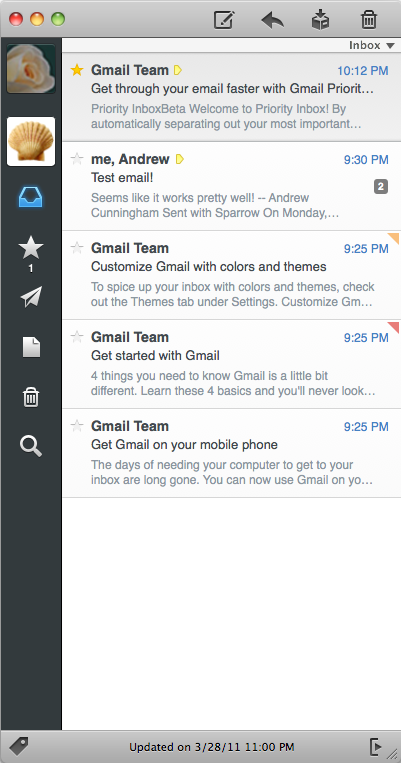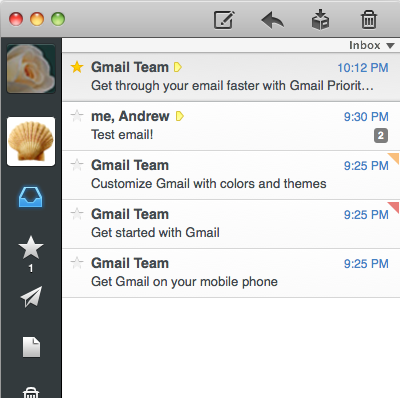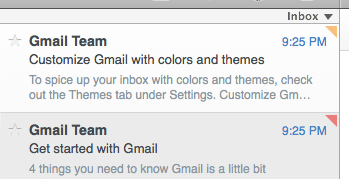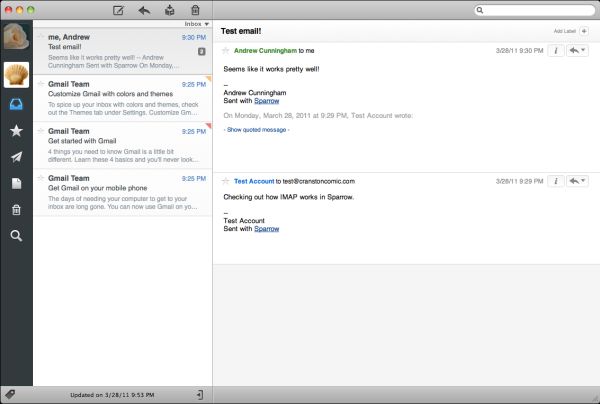Sparrow: An OS X IMAP Client for Gmail Users
by Andrew Cunningham on April 7, 2011 3:00 PM EST
![]()
If you’ve ever connected an IMAP email client like Apple Mail or Mozilla Thunderbird to Gmail, you know it can do a few weird things: Deleting an email from the client will usually remove it from the Inbox, but won’t actually delete it from the server – the email lives on in the All Mail folder instead of actually going away. IMAP clients also create and use their own Drafts, Trash, and Sent folders by default, instead of Gmail’s built-in folders. Because of this, drafts saved in the IMAP client can’t be edited in the Web client (and vice-versa) extraneous labels are created in the web client, and in general things just don’t mesh as smoothly as they should unless you know which settings to change in which client.
Enter Sparrow, which was built from the ground-up with Gmail users in mind – it shows threaded email conversations, it works around all of Gmail’s aforementioned idiosyncrasies, and it does so in an appealing minimalist package without any additional finessing or configuring. The 1.1 update even adds support for the Priority Inbox feature if you have it enabled.
Visually and functionally, Sparrow draws primarily from two things: the Twitter for Mac app, and the iOS mail client.

Sparrow displays all of your accounts vertically on the left-hand side of the app – to switch accounts, just click a different profile picture. Buttons are available for your main folders (Inbox, Sent, Drafts, Trash) and for basic functions (New message, Reply, Archive, Delete). Double clicking an email thread will open it up in a second window, where you can read all the messages, reply, and add or change labels.
If you want things to get even more compact, you can enable the “hide message preview” setting and fit even more messages into a given window.

If you hit the button in the bottom-right corner of the app, a message pane will slide out and you can view your emails without opening a second window. In this view, Sparrow is not much different from the iPad mail client in landscape mode.
You can star your messages as you normally would in Gmail, and your labels are denoted by small color-coded triangles. These triangles are pretty subtle and they don’t sync to the colors you have your labels set to in the web client, but if you’re a heavy label user you’ll probably get over these gripes.

Sparrow works best if you use Gmail without too many of the Google Labs add-ons enabled. People who rely heavily on, say, Multiple Inboxes or Undo Send (a personal favorite for so, so many reasons) may miss them in Sparrow.











20 Comments
View All Comments
Andrew.a.cunningham - Thursday, April 7, 2011 - link
Think of it less as a biased advertisement and more as an experiment, and keep in mind that not all experiments turn out as well as you'd like them to. :-)Anand and I have talked a bit about the kind of writing he'd like me to do for the site, and there's an interest in putting up material that branches out a bit from AT's typical in-depth hardware reviews in subject matter - software pieces and shorter, newsier posts - without sacrificing the site's perspective or the value it adds to stories that other sites just copy-and-paste.
I'll admit that this article didn't turn out quite like I had wanted it to, but new things and beginnings can be difficult, and sometimes the best way to learn what works and what doesn't is just to try it out. Critical and constructive feedback is a key part of that process. What sort of software would you rather read about? What sort of things are you looking for in a software review?
softdrinkviking - Friday, April 8, 2011 - link
i thought about your question for a bit, and here is my reaction:typically, people go to a specific website to learn about and discuss software.
for example, i use a lot of audio editing programs, so i would naturally go to an audio forum or other related site to read about features and usability.
it is true what Pub & Kyle said about the conflicts of interest. a lot of the time you will read a review of something that is like reading one of those advert-spec sheets they hand out at a store; it's obviously trying to sell you something.
one would think that free programs would have a more honest picture to paint, but what ends up happening (IMHO) is that people are so happy to get a free program that they are extremely generous with praise.
so, back to your question; what can you offer in terms of software reviews...
personally, i would like to see software comparisons.
i think comparisons are a good idea because they inherently bring out criticisms of the products.
the types of stuff i would be interested in reading about are probably not the same as what the next guy wants, so it may be immaterial, but here goes anyway...
sound editing, film editing, multimedia apps for specific purposes like AV file management (transcoding, compression, ect.) or even something like online radio station aggregaters.
of course, the problem with all that is that people traditionally go to specific sites to find info on their little specific interests in an environment that "reassures" them that they are in the company of others who care or something like that.
so you would have to overcome that somehow; you would have to give people a reason to take your word over a site that specifically caters to the kind of software you are writing about.
back to what Pub & Kyle were saying, you could try to be the "anti-conflict of interest" reviewer.
you could collect info on several different approaches to the same kind of software, like "five popular transcoding programs," for example, and write a serious comparison of them.
the trick would be to show each one's strengths and, more importantly, weaknesses, so that people can choose which one they prefer.
many people like to choose things, even if they will never look at it again.
Andrew.a.cunningham - Friday, April 8, 2011 - link
One thing I always liked about AT as a reader was that the articles didn't just say "here's a thing, and here's what I think about it," but "here's a thing, here's absolutely everything we know about what makes it tick, and here's what I think about it." Bringing that mentality to a software review is something I really want to work on. Trying to provide as many hard facts as possible goes a long way toward removing potential bias.My worry about reviewing more "niche" software is that each article would appeal to only a small subsection of the readership. It might be best, at least for now, to target software that appeals to more people, or that has a function more directly related to the hardware we write about.
Thanks a lot for your suggestions! If nothing else, this has been a good learning experience for me. :-)
ioannis - Saturday, April 9, 2011 - link
I agree with 'softdrinkviking'. Comparisons are much more useful than simple reviews. Also, being AnandTech, I would also expect testing software from a different angle, that of performance and resource usage. in this case, which client uses less resources, how fast does it do a task and maybe (since we are talking about software and many things are subjective), how fast is it for the user to achieve given tasks (via careful thinking of the UI design). On that line of thought, it might be worth creating a new benchmark suite/metric(s) for usability.these are my two cents
Wolfpup - Thursday, April 7, 2011 - link
...I thought Apple's default configuration in their mail client already handled Gmail okay? At least on my iPod, if I configure it using Apple's settings (instead of Google's) it behaves more or less like I'd expect-like delete a message, it's actually deleted, not just un-labled.I'd thought Apple's OS X client would be the same?
Does look like this comes closer to replicating the web interface though, which might be nice. If I had a Mac I'd definitely give it a shot.
jb510 - Friday, April 8, 2011 - link
Measuring hardware is inherently objective. Sure there are some subjective aspects in terms of design but for the most part it's objective testing and reporting. AT excells at this like none other.Software doesn't lend itself to objective testing... For the most part its impossible to measure differences between software. I'm not sure where I where I want AT involved in software reviews. I suppose finding two software products that address the same problem or need and then comparing them might work but there isn't a lot of software like that... Compare openoffice vs. Office (been done too many times)... Compare Photoshop vs. GIMP (been done too many times)... I just am not sure where AT has anything unique to add to software reviews. In depth reviews of high end products (final cut, lightroom, logic) might be the only place but even then I'm doubtful.
On the subject of sparrow... I gave it a very brief try and decided I see nothing wrong with Apple Mail so why bother learning something new, but I might give it one more look... One thing I think that might of added to AT's review would be to discuss it's interface relative to what we're seeing in the developer preview of Lion. In that light Sparrow looks ahead of it's time.
Griswold - Saturday, April 9, 2011 - link
"Anandtech is a hardware site, it's true, but what good is that powerful, perfectly-overclocked rig you bought if you don't have anything to run on it?"Since when do mac users overclock their rigs? :P
Zoomer - Wednesday, April 13, 2011 - link
I'm sure you can overclock on the Gigabyte EP45. The C2Q is getting a little dated, though.jed22281 - Sunday, April 10, 2011 - link
Tried sparrow, it takes the simplicity thing way too far IMO.Postbox can do every thing sparrow does, plus "much" more (just diff UI paradigms).
And in a UI that's much better than Tbird for Mac users.